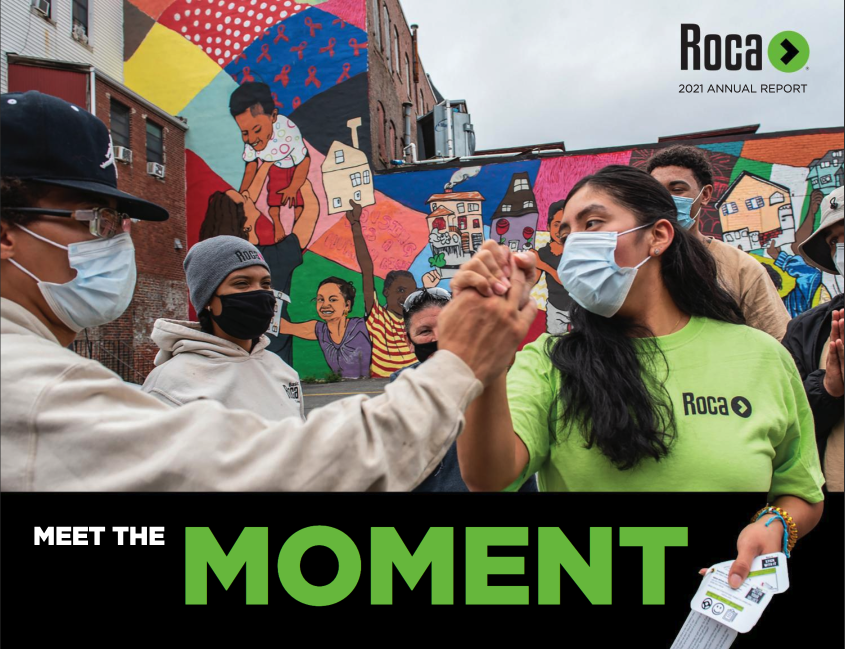Roca
Challenge
As an organization, Roca has warrior DNA — priding themselves on working with youth that other organizations turn away. Roca fights hard to help the young people it serves. The organization’s messages reflected their relentless approach. In an effort to distinguish themselves from other youth-serving organizations, Roca described the young people they serve in the most hard-hitting way they could. Inadvertently, this approach was alienating or discouraging to some of their key audiences, including individual donors and potential partners. Together, Wonder and Roca set out to refocus the organization’s messaging — ensuring that it was true to Roca’s identity and values and better connected with their audiences.
Heartwired Insight & Strategy
In talking about their critical work, Roca led with the serious challenges faced by the young people they serve and their communities. These messages defined young people by their experiences with violence or incarceration, which made it harder for some audiences to also hear Roca’s messages of hope and empathy. Wonder’s research showed that these messages were unintentionally reinforcing negative stereotypes about the young people they worked with and not leaving space for audiences to feel sympathetic. When asked to share their thoughts on hearing some of Roca’s messaging, representatives of key audience segments said things like “hopeless,” “dangerous,” and “scary.” These were people who wanted to help, but some of Roca’s messaging was making them feel that the task was insurmountable.
Of course the young people that Roca works with do face enormous challenges and Roca couldn’t and wouldn’t sugarcoat them. How could Roca reach audiences in truthful, meaningful ways that leave room for hope?
The core of this shift was finding new ways to lift up the humanity of the people Roca serves. In their work every day, Roca staff were committed to every person they served, believing that change was possible for everyone — but that was getting lost in their communications.
Wonder helped Roca harness that humanity in their organizational narrative so their words could match the passion they bring to their work. The key to this shift was defining people not by their behaviors and challenges, but as human beings with lived experiences beyond their control.
Wonder also worked with Roca to choose images that capture their work and showcase the humanity of the young people and communities Roca fights for. More effective images highlight the bonds among people and the resilience of communities by lifting up things like hugs, handshakes, and high-fives, and highlighting the people and places that make up communities through things like families, friends, and murals.
Recommendations in Action
After working with Wonder, Roca’s messaging shifted to describe young people’s experiences with trauma rather than defining them by their worst behaviors. This approach provides audiences with an opportunity to better understand the root causes of violence and to develop empathy. Instead of talking about young people who “carry guns and knives” or “are the most at-risk,” Roca now describes the young people they serve as: “16-24 year olds who have experienced trauma… at the center of urban violence.”
Roca’s messaging after working with Wonder focuses on their unique program model and dedicated staff:
“Because you can’t undo a lifetime of trauma overnight, Roca youth workers develop deep relationships over 2-4 years that help young people begin to heal from their hurt and anger, the key to success later on.”
Roca also highlights their incredible results, which reinforce the hope that change is possible. For example, their Young Men’s program is now described as:
“Roca works with 1,000 young men annually who are at the center of urban violence, traumatized and stuck. For every 10 young people who were committing violence before entering the program, 8 or 9 stay out of trouble and have no new incarcerations.”
Roca also works to elevate the hopes and aspirations of the young people they serve — especially in the stories of young people like Trevor from Springfield, MA, who have been through their program. Rather than defining Trevor by the challenges he has faced, Roca is spotlight Trevor’s full humanity. You learn about his job and his deep commitment to his six-year old son, and his relationship with his employer: “They see me as a good guy.” In the heartfelt video, Trevor shares a laugh with his supervisor and takes great pride in his work.
 These messages and stories are true to Roca’s DNA as an organization, which is critical. While not shying away from the challenges facing young people, Roca’s messaging weaves in humanity and hope in a way that leaves room for the audience to understand the seriousness of the problems while giving their stakeholders strong cause for optimism.
These messages and stories are true to Roca’s DNA as an organization, which is critical. While not shying away from the challenges facing young people, Roca’s messaging weaves in humanity and hope in a way that leaves room for the audience to understand the seriousness of the problems while giving their stakeholders strong cause for optimism.

This photo encapsulates Wonder’s recommendations on visuals perfectly: it highlights real people interacting with others in their community with the powerful image of the mural adding another meaningful layer.
Today, Roca is regularly utilizing this new approach and finding ways to apply this learning to how they communicate – and think about – their amazing work.
“We have always pushed ourselves to try to make sure Roca’s messaging matches the seriousness of the moments our young people are facing right alongside the tremendous optimism we see in our young people every day. We deeply appreciate Wonder working with us to strengthen our messaging and bring it to a new place so we can better articulate what we do and how we do it.” — Allie Livezey Maynard, Vice President, Revenue Generation and Communications
